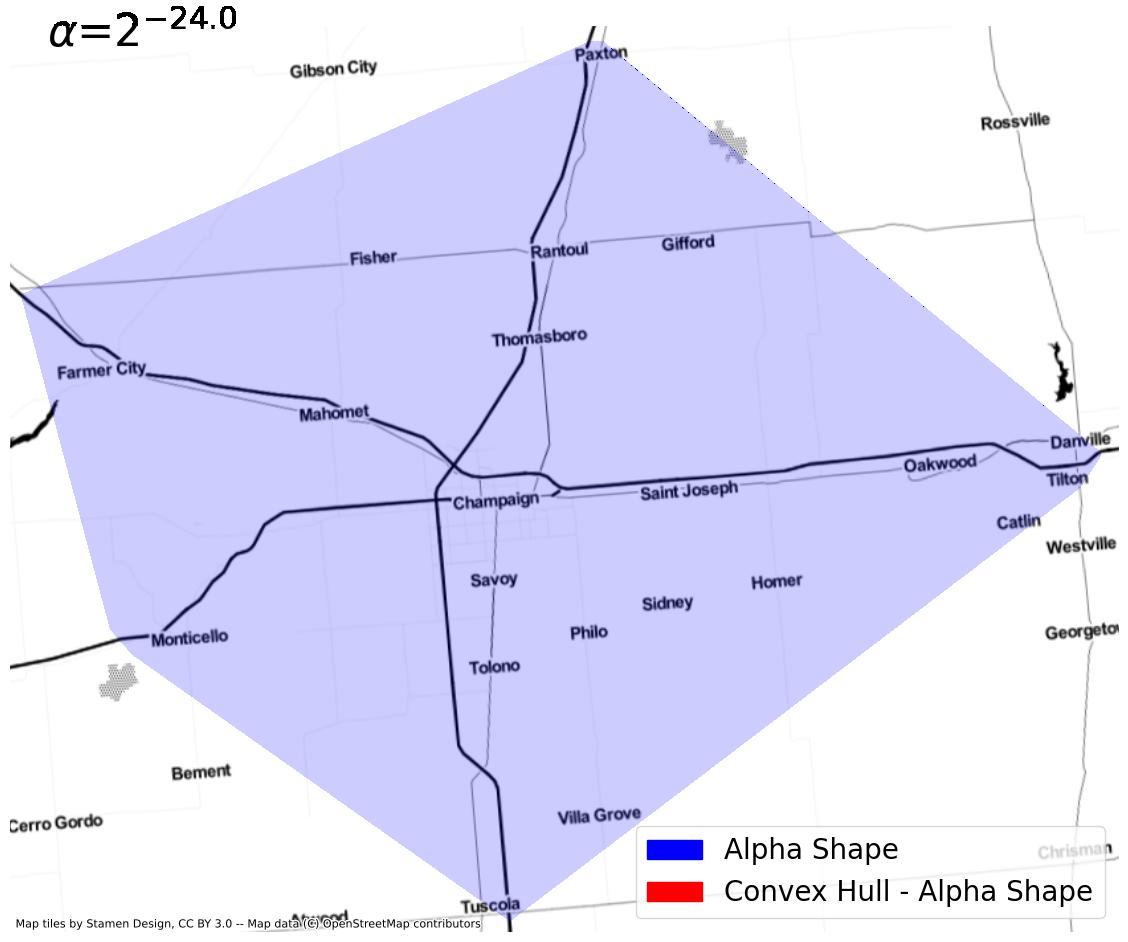This project focused on the development of algorithms, methods, and software to increase the accuracy and scalability of spatial accessibility analysese. We have also explored how best to utilize new data sources (OSM, Uber Movement, etc.) to improve our analyses.
A GIF demonstrating the difference between using Convex Hull and Alpha Shapes for determining catchments in spatial accessibility analyses.
Associated Publications
Journal Articles
2024
An Areal Approach to Spatial Accessibility Analysis
Geographical Analysis,
2024
Place-based spatial accessibility quantifies the distribution of access to goods and services across space. The Two-Step Floating Catchment Area (2SFCA) family of methods have become a default tool for spatial accessibility analysis in part due to their intuitive approach and interpretability. This family of methods relies on calculating catchment areas around supply locations to estimate the area and population that may utilize them. However, these “catchment areas” are generally defined by origin-destination matrices of travel-time, giving us point-to-point distances and not polygons with actual area. This means that population geographies (census tracts, blocks, etc.) are binarily included or excluded, with no room for partial inclusion. When using nongranular data, which is often the case due to data privacy restrictions, this has the potential to cause significant errors in accessibility measurements. In this article, we propose Areal 2SFCA: a new approach that considers the area of overlap between travel-time polygons and population geographies. We demonstrate the effectiveness of the Areal 2SFCA method using a case study that compares the Enhanced Two-Step Floating Catchment Area (E2SFCA) and Areal E2SFCA for the state of Illinois in the USA using multiple population granularities.
SPASTC: A Spatial Partitioning Algorithm for Scalable Travel-time Computation
International Journal of Geographical Information Science,
2024
Travel-time computation with large transportation networks is often computationally intensive for two main reasons: 1) large computer memory is required to handle large networks; and 2) calculating shortest-distance paths over large networks is computing intensive. Therefore, previous research tends to limit their spatial extent to reduce computational intensity or resolve computational intensity with advanced cyberinfrastructure. In this context, this article describes a new Spatial Partitioning Algorithm for Scalable Travel-time Computation (SPASTC) that is designed based on spatial domain decomposition with computer memory limit explicitly considered. SPASTC preserves spatial relationships required for travel-time computation and respects a user-specified memory limit, which allows efficient and large-scale travel-time computation within the given memory limit. We demonstrate SPASTC by computing spatial accessibility to hospital beds across the conterminous United States. Our case study shows that SPASTC achieves significant efficiency and scalability making the travel-time computation tens of times faster.
2023
Daily Changes in Spatial Accessibility to ICU Beds and Their Relationship with the Case-Fatality Ratio of COVID-19 in the State of Texas, USA
Applied Geography,
2023
During the COVID-19 pandemic, many patients could not receive timely healthcare services due to limited availability and access to healthcare resources and services. Previous studies found that access to intensive care unit (ICU) beds saves lives, but they overlooked the temporal dynamics in the availability of healthcare resources and COVID-19 cases. To fill this gap, our study investigated daily changes in ICU bed accessibility with an enhanced two-step floating catchment area (E2SFCA) method in the state of Texas. Along with the increased temporal granularity of measurements, we uncovered two phenomena: 1) aggravated spatial inequality of access during the pandemic, and 2) the retrospective relationship between insufficient ICU bed accessibility and the high case-fatality ratio of COVID-19 in rural areas. Our findings suggest that those locations should be supplemented with additional healthcare resources to save lives in future pandemic scenarios.
Conference Proceedings
2023
An Agent-Based Modeling Approach to Spatial Accessibility
Forum 2023 - Harnessing the Geospatial Data Revolution for Sustainability Solutions,
2023
Place-based spatial accessibility represents the ability of populations within geographic units to access goods and services, and thus is an important indicator for sustainable development. Existing spatial accessibility models treat population as simply demand, calculating statistics or optimizing average cost for the population within each geographic unit, rather than modeling individual decisions. This paper proposes AgentAccess, a general-purpose Agent-Based Model (ABM) for spatial accessibility analysis. An ABM framework brings us closer to reality by simulating individual and imperfect decision-making. We introduce the model and compare its results against existing spatial accessibility models using a case study of hospital beds in Cook County, IL, USA.
Impacts of Catchments Derived from Fine-Grained Mobility Data on Spatial Accessibility
12th International Conference on Geographic Information Science (GIScience 2023),
2023
Spatial accessibility is a powerful tool for understanding how access to important services and resources varies across space. While spatial accessibility methods traditionally rely on origin-destination matrices between centroids of administrative zones, recent work has examined creating polygonal catchments - areas within a travel-time threshold - from point-based fine-grained mobility data. In this paper, we investigate the difference between the convex hull and alpha shape algorithms for determining catchment areas and how this affects the results of spatial accessibility analyses. Our analysis shows that the choice of how we define a catchment produces differences in the measured accessibility which correlate with social vulnerability. These findings highlight the importance of evaluating and communicating minor methodological choices in spatial accessibility analyses.
